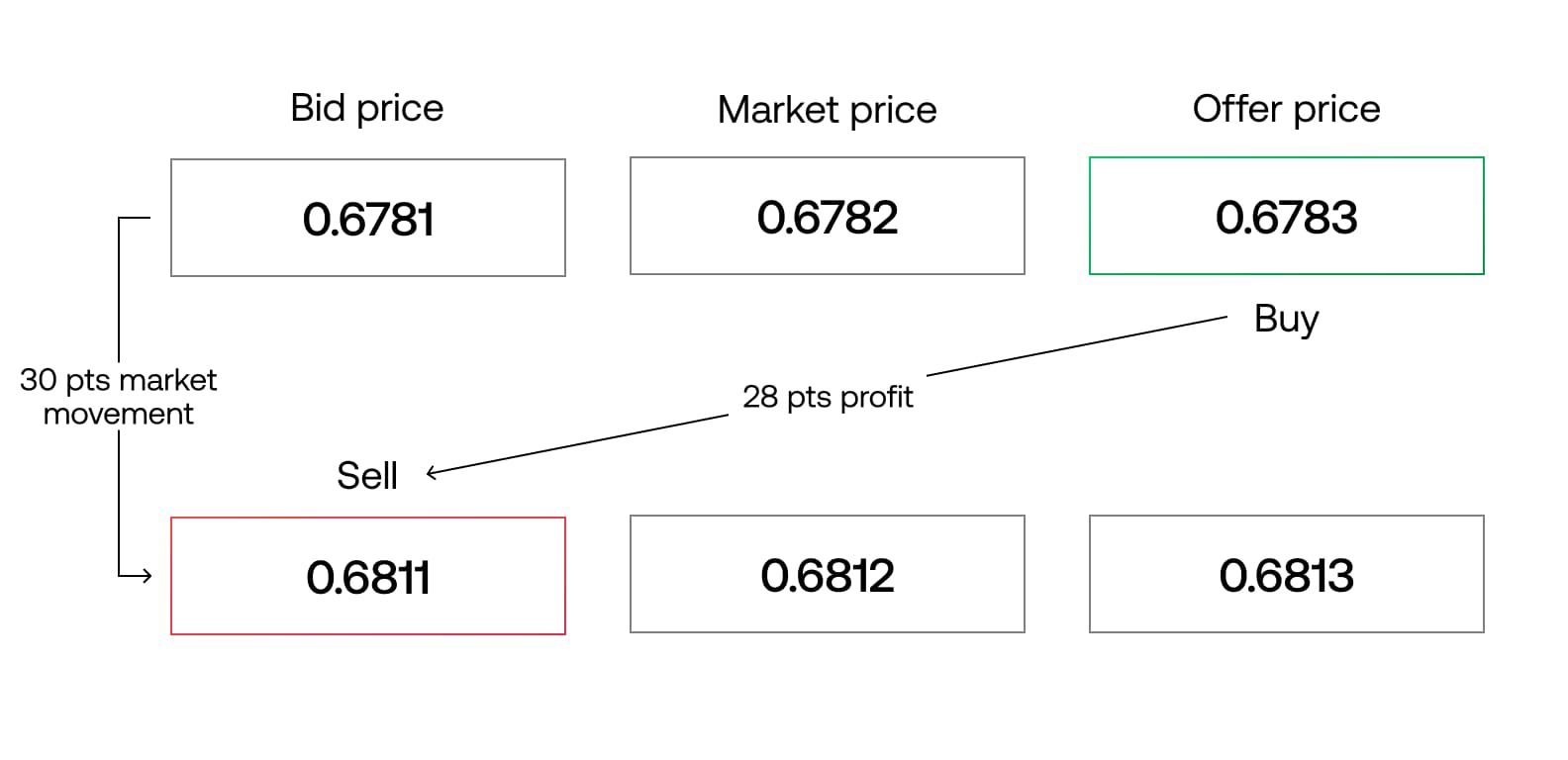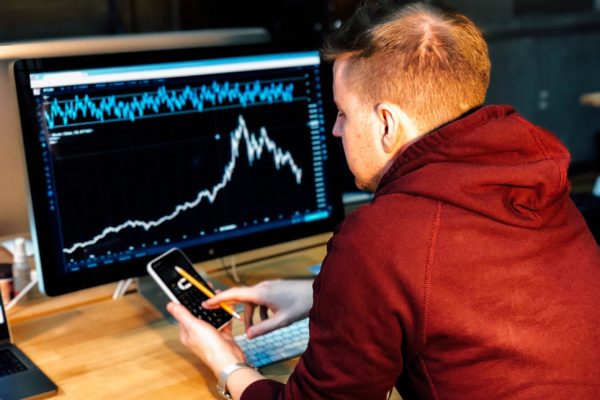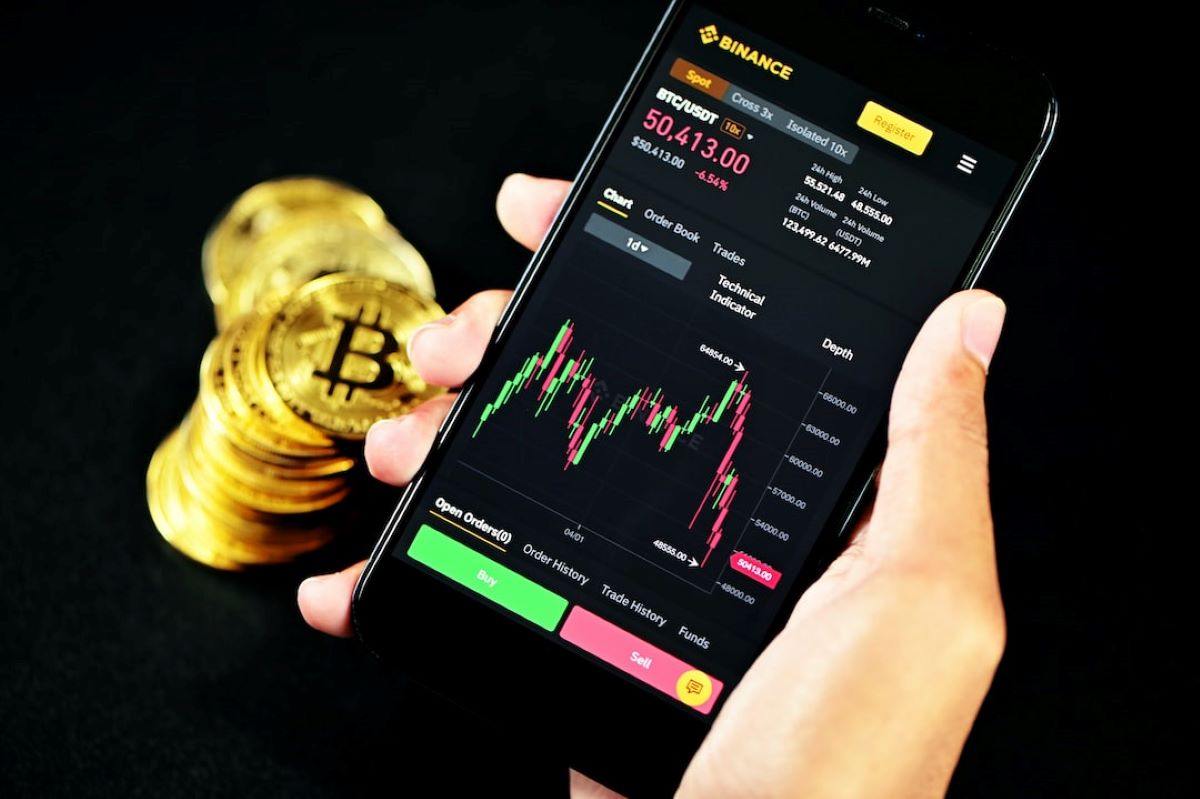

Finance
How To Start With Forex Trading
Published: December 22, 2023
Learn how to start with forex trading and take control of your finances. Find expert tips, strategies, and resources to excel in the world of finance.
(Many of the links in this article redirect to a specific reviewed product. Your purchase of these products through affiliate links helps to generate commission for LiveWell, at no extra cost. Learn more)
Table of Contents
- Introduction
- Understanding Forex Trading
- Setting Up a Forex Trading Account
- Choosing a Forex Broker
- Learning Forex Trading Basics
- Developing a Trading Strategy
- Forex Trading Technical Analysis
- Fundamental Analysis in Forex Trading
- Risk Management in Forex Trading
- Forex Trading Psychology
- Forex Trading Tips for Beginners
- Common Mistakes to Avoid in Forex Trading
- Forex Trading Glossary
- Conclusion
Introduction
Welcome to the exciting world of forex trading! If you’re looking to venture into the financial markets and want to explore a dynamic and potentially lucrative opportunity, then forex trading might be just what you’re seeking.
Forex, short for foreign exchange, is the decentralized global market where currencies are bought and sold. It’s the largest and most liquid market in the world, with trillions of dollars exchanged daily. Unlike traditional stock markets, forex operates 24/7, giving traders the flexibility to participate at any time.
The allure of forex trading lies in its accessibility and potential profitability. With the advancement of technology, anyone with an internet connection and a small capital can trade forex from the comfort of their own home. Additionally, forex trading offers a wide range of financial instruments, allowing traders to diversify their portfolios and take advantage of various market conditions.
However, it’s important to note that forex trading is not a get-rich-quick scheme. It requires knowledge, practice, and discipline. Without understanding the basics and implementing sound trading strategies, it’s easy to fall victim to losses. Education and experience are key factors in succeeding in this challenging yet rewarding field.
In this comprehensive guide, we will walk you through the essential aspects of forex trading. Whether you’re a complete beginner or have some trading experience, you’ll find valuable information and insights to help you navigate the forex market with confidence.
From setting up a forex trading account to understanding fundamental and technical analysis, risk management, and trading psychology, we’ll cover all the essential topics that will empower you to make informed trading decisions. We’ll also provide valuable tips and highlight common mistakes to avoid, ensuring you start your forex trading journey on the right track.
So, if you’re ready to dive into the exciting world of forex trading and unlock the potential to transform your financial future, let’s get started!
Understanding Forex Trading
Forex trading involves the buying and selling of currencies in the foreign exchange market. It operates on the principle of exchanging one currency for another at a specified exchange rate. The goal of a forex trader is to profit from the fluctuations in currency prices by speculating on which currency will appreciate or depreciate in value in relation to another.
The forex market is decentralized, meaning that there is no central exchange where all transactions take place. Instead, trading occurs electronically over-the-counter (OTC), with participants connected through computer networks. This allows for trading to happen 24 hours a day across different time zones, excluding weekends.
In the forex market, currency pairs are traded. The first currency in the pair is called the base currency, while the second currency is the quote currency. For example, in the EUR/USD pair, the euro is the base currency, and the US dollar is the quote currency. The exchange rate represents the value of one currency in relation to the other. If you believe the euro will strengthen against the US dollar, you would buy the EUR/USD pair, whereas if you predict the opposite, you would sell the pair.
Forex trading offers several advantages over other financial markets. Firstly, the forex market is highly liquid, meaning that there is a high volume of buyers and sellers, which ensures that traders can easily enter or exit trades at any time. This liquidity also results in tight bid-ask spreads, reducing trading costs for traders.
Another benefit of forex trading is the ability to use leverage. Leverage allows traders to control larger positions in the market with a smaller amount of capital. While leverage can amplify profits, it’s important to note that it can also lead to substantial losses if not managed properly. Risk management strategies should always be implemented to protect against potential downsides.
Additionally, the forex market offers a high level of volatility, presenting opportunities for traders to profit from price movements. Volatility refers to the rapid and significant changes in currency prices, influenced by various economic, political, and social factors. Traders can take advantage of both upward and downward trends in the market.
To be successful in forex trading, it’s crucial to stay informed about economic events, geopolitical developments, and other factors that can impact currency prices. Fundamental analysis and technical analysis are two commonly used approaches in forex trading. Fundamental analysis examines economic indicators, government policies, and market sentiment, while technical analysis uses historical price data and indicators to predict future price movements.
By understanding the fundamentals of forex trading and consistently educating yourself about the market dynamics, you’ll be equipped with the knowledge and skills necessary to make informed trading decisions. In the following sections, we will dive deeper into setting up a forex trading account, choosing a forex broker, learning trading basics, developing a strategy, managing risks, and much more. So, let us continue our journey into the world of forex trading!
Setting Up a Forex Trading Account
To get started with forex trading, the first step is to set up a forex trading account. This is the platform that will allow you to access the forex market and execute your trades. Here are the key steps to follow in setting up your forex trading account:
- Choose a Reliable Forex Broker: Selecting a reputable forex broker is essential for a smooth trading experience. Look for a broker that is regulated by a recognized financial authority, offers a user-friendly trading platform, competitive spreads, and a wide range of currency pairs to trade. It’s also important to consider the broker’s customer support and educational resources.
- Complete the Account Registration: Once you have selected a broker, visit their website and complete the account registration process. This typically involves providing your personal information, such as your name, address, email, and contact details. Some brokers may also require additional documents for verification, such as proof of identity and address.
- Fund Your Account: After your account is registered and verified, it’s time to deposit funds into your trading account. Most brokers offer various funding options, including bank transfers, credit/debit card payments, and online payment processors. Choose the method that suits you best and deposit an amount that you are comfortable trading with.
- Choose a Trading Platform: The trading platform is a software application that allows you to analyze the market, place trades, and manage your account. Most forex brokers offer popular platforms like MetaTrader 4 (MT4) or MetaTrader 5 (MT5). These platforms are intuitive, feature-rich, and provide access to a wide range of trading tools and indicators.
- Configure the Trading Platform: Once you have chosen a trading platform, you’ll need to configure it according to your preferences. This includes setting up your preferred chart timeframes, choosing the desired color schemes, and customizing any indicators or expert advisors you wish to use. Familiarize yourself with the different functions and tools available on the platform to maximize your trading potential.
- Practice with a Demo Account: Many brokers offer the option to open a demo account, which allows you to practice trading using virtual funds. This is a valuable opportunity to familiarize yourself with the trading platform, test different strategies, and gain confidence before risking real money. Take advantage of the demo account to refine your skills and develop a solid trading plan.
- Start Live Trading: Once you feel comfortable and confident with your trading skills, it’s time to transition to live trading. Ensure that you have a clear trading strategy and risk management plan in place. Start with smaller position sizes and gradually increase your exposure as you gain experience and consistent profitability.
Remember, setting up a forex trading account is just the beginning. It’s important to continuously educate yourself about the forex market, refine your trading skills, and adapt to changing market conditions. Stay disciplined, maintain proper risk management, and be patient in your journey as a forex trader.
Choosing a Forex Broker
Choosing a reliable and reputable forex broker is crucial for your success in forex trading. With countless brokers available in the market, it can be overwhelming to make the right choice. Here are some key factors to consider when selecting a forex broker:
- Regulation and Security: It is essential to choose a broker that is regulated by a reputable financial authority. Regulatory bodies monitor brokers to ensure compliance with strict guidelines, protecting traders’ interests and maintaining the integrity of the market. Regulation enhances transparency and trust, providing a safer trading environment.
- Trading Platform: The trading platform is your gateway to the forex market. It should be user-friendly, stable, and equipped with essential tools and features. Popular platforms like MetaTrader 4 (MT4) and MetaTrader 5 (MT5) are widely used and offer comprehensive charting capabilities, technical analysis tools, and automated trading options.
- Range of Tradable Instruments: Consider the variety of currency pairs and other financial instruments offered by the broker. The availability of a wide range of assets allows for diversification and the ability to take advantage of different market opportunities. Additionally, check if the broker offers other trading products like commodities, indices, or cryptocurrencies if you are interested in expanding your trading portfolio.
- Spreads and Fees: Competitive spreads can significantly impact your trading costs. A narrower spread means lower transaction costs, increasing the profitability of your trades. Look for brokers that offer tight spreads, particularly for major currency pairs. Additionally, compare and analyze the fees associated with deposits, withdrawals, and any other services provided by the broker.
- Execution Speed and Order Types: The execution speed of trades is crucial in the forex market, where prices can fluctuate rapidly. A broker with fast and reliable order execution ensures that your trades are executed promptly at the desired price without slippage. It’s also important to check if the broker offers different order types, such as market orders, limit orders, stop orders, and more, to accommodate your trading strategies.
- Customer Support: A broker’s customer support can play a crucial role in your trading experience. Look for brokers that offer responsive and multilingual support, accessible via live chat, phone, or email. Prompt and helpful customer service can provide assistance in resolving technical issues, answering queries, and addressing any concerns that may arise during your trading journey.
- Educational Resources: Choose a broker that values trader education and offers comprehensive educational resources. This may include tutorials, webinars, e-books, video courses, and market analysis. A broker that invests in trader education shows commitment to their clients’ success and can help you enhance your trading skills and knowledge.
- Reputation and Reviews: Research the reputation and reviews of potential brokers. Look for feedback from other traders to gauge their experiences with the broker’s services. Honest reviews from reliable sources can provide insights into the broker’s reliability, performance, customer satisfaction, and overall credibility.
Take the time to compare different brokers, considering these factors and your individual trading needs and preferences. Opening a demo account with a few brokers can also give you hands-on experience with their trading platforms and services before making a final decision. Remember, selecting the right forex broker is an important step towards achieving your trading goals, so choose wisely.
Learning Forex Trading Basics
Before diving into the world of forex trading, it’s crucial to understand the basics. Here are some essential concepts and terms that every aspiring forex trader should familiarize themselves with:
- Currency Pairs: Forex trading involves the simultaneous buying of one currency and selling of another. Currencies are quoted in pairs, such as EUR/USD (euro/U.S. dollar) or GBP/JPY (British pound/Japanese yen). The first currency in the pair is the base currency, and the second currency is the quote currency.
- Exchange Rate: The exchange rate represents the value of one currency relative to another. For example, an exchange rate of 1.25 for the EUR/USD pair means that 1 euro is equivalent to 1.25 U.S. dollars. Exchange rates fluctuate due to various factors, including economic indicators, geopolitical events, and market sentiment.
- Bid and Ask Price: In a currency pair, the bid price is the price at which you can sell the base currency, while the ask price is the price at which you can buy the base currency. The bid-ask spread represents the difference between the two prices and is influenced by market liquidity and the broker’s fees.
- Long and Short Positions: When trading forex, you have the flexibility to take either a long or short position. Going long means buying a currency with the expectation that its value will rise, allowing you to sell it at a higher price in the future. Going short means selling a currency with the anticipation that its value will decline, enabling you to buy it back at a lower price.
- Leverage: Leverage allows you to control a larger position in the market with a smaller amount of capital. It is expressed as a ratio (e.g., 1:100 or 1:500), indicating how much you can magnify your trading position. While leverage can amplify your potential profits, it also increases the risk of losses, so it should be used with caution and proper risk management strategies in place.
- Market Order: A market order is an instruction to buy or sell a currency pair at the current market price. It guarantees execution but does not guarantee the exact price at which the order will be filled. Market orders are typically used when you want to enter or exit a trade quickly, regardless of the current price.
- Limit Order: A limit order is an instruction to buy or sell a currency pair at a specific price or better. It allows you to set a target price at which you want your order to be executed. Limit orders are useful for entering the market at a more favorable price or to close a position when the market reaches your desired level.
- Stop Order: A stop order is an instruction to buy or sell a currency pair when the price reaches a specific level. It is used to limit potential losses or to capture profits by automatically triggering a trade when the price reaches a predefined level. There are two types of stop orders: stop-loss orders to limit losses and take-profit orders to secure profits.
- Technical Analysis: Technical analysis involves analyzing historical price data to identify patterns, trends, and price levels. Traders use various tools and indicators to make predictions about future price movements. Technical analysis helps traders make informed decisions based on price patterns and market psychology.
- Fundamental Analysis: Fundamental analysis involves studying economic indicators, geopolitical events, and market news to evaluate the intrinsic value of a currency. This analysis considers factors such as interest rates, GDP growth, employment data, inflation, and political developments. Fundamental analysis helps traders understand the underlying factors that can influence currency values.
These are just a few of the key concepts and terms that form the foundation of forex trading. It’s essential to continue learning and exploring the intricacies of the forex market. Read books, attend webinars, join forums, and consider taking courses to deepen your understanding. The more you educate yourself, the better equipped you’ll be to make informed trading decisions and navigate the dynamic world of forex.
Developing a Trading Strategy
A trading strategy is a set of rules and guidelines that govern your approach to trading the forex market. Having a well-defined trading strategy is essential for consistent profits and managing risk effectively. Here are the key steps to developing a trading strategy:
- Define Your Trading Goals: Determine your financial goals, risk tolerance, and time commitment for trading. Are you looking for short-term profits or long-term growth? Do you prefer a high-risk, high-reward approach or a more conservative strategy? Understanding your goals and risk appetite will help shape your trading strategy.
- Choose a Trading Style: Select a trading style that aligns with your personality and preferences. There are several common trading styles, including day trading, swing trading, and position trading. Day traders open and close trades within the same trading day, while swing traders hold trades for a few days to weeks, and position traders hold trades for months to years. Select a style that suits your schedule and trading style.
- Technical or Fundamental Analysis: Decide whether you will primarily rely on technical analysis, fundamental analysis, or a combination of both. Technical analysis involves studying historical price patterns and indicators to predict future price movements. Fundamental analysis focuses on analyzing economic data, news events, and geopolitical factors to predict currency movements. Understanding which analysis method resonates with you will help shape your trading strategy.
- Select Indicators and Tools: If you opt for technical analysis, choose the indicators and tools that you will include in your trading strategy. Some popular technical indicators include moving averages, oscillators, and trend lines. Experiment with different indicators and find a combination that works best for your trading style and preferences.
- Set Entry and Exit Rules: Determine the criteria for entering and exiting trades. This may include specific price levels, patterns, or indicators that signal a trade opportunity. For example, you might enter a trade when a currency pair breaks out of a key resistance level or when a specific indicator generates a buy/sell signal. Similarly, establish rules that will prompt you to exit a trade, such as reaching a profit target or a predetermined stop-loss level.
- Implement Risk Management: Establish risk management rules to protect your capital from significant losses. This includes determining the percentage of your account that you are willing to risk per trade, setting stop-loss orders to limit losses, and using proper position sizing techniques. Risk management is crucial to ensure long-term success in forex trading.
- Backtest and Demo Trade: Before applying your trading strategy to live trading, backtest it using historical data to evaluate its performance. This involves applying your strategy to past market conditions to see how it would have performed. Additionally, practice trading your strategy on a demo account to gain confidence and ensure consistency in executing your trading plan.
- Continuously Monitor and Adjust: No trading strategy is perfect, and the forex market is constantly evolving. Monitor your strategy’s performance in real-time and be willing to make adjustments as needed. Keep a trading journal to track your trades and analyze your results to identify areas for improvement. Adaptability is key in ensuring your strategy remains effective as market conditions change.
Remember, developing a trading strategy takes time and experience. Be patient, stay disciplined, and be willing to learn from both your successes and failures. As you gain more knowledge and experience, you can refine and improve your strategy to achieve consistent profitability in the exciting world of forex trading.
Forex Trading Technical Analysis
Technical analysis is a popular approach used by forex traders to analyze market dynamics and make trading decisions based on historical price patterns and indicators. By studying past price movements, traders aim to identify trends, reversal patterns, and other signals that can help predict future price movements. Here are the key components of forex trading technical analysis:
- Chart Analysis: Technical analysis relies heavily on analyzing price charts. Traders use different types of charts, including line charts, bar charts, and candlestick charts, to visualize price movements over a specific time period. Charts help identify trends, support and resistance levels, and patterns that can provide valuable insights into future price action.
- Trend Analysis: Traders often look for trends, which are persistent and directional price movements. Trends can be categorized as uptrends (higher highs and higher lows), downtrends (lower highs and lower lows), or sideways trends (a range-bound market). Identifying the prevailing trend is crucial for making informed trading decisions and aligning with the market direction.
- Support and Resistance Levels: Support levels are price levels at which buying interest is expected to outweigh selling pressure, causing prices to bounce back up. Resistance levels, on the other hand, are price levels at which selling interest is expected to outweigh buying pressure, causing prices to reverse downwards. Traders use these levels to identify potential entry and exit points for trades.
- Chart Patterns: Chart patterns are formed by price movements and can provide insights into potential market reversals or continuations. Common chart patterns include head and shoulders, double tops and bottoms, triangles, and flags. Traders pay attention to the formation of these patterns as they can indicate the future direction of prices.
- Indicators: Technical analysis involves the use of a variety of indicators to help identify trends, momentum, and potential turning points in the market. These include moving averages, oscillators like the Relative Strength Index (RSI), and Fibonacci retracement levels. Indicators can be used individually or in combination to provide additional confirmation signals for trading decisions.
- Multiple Time Frame Analysis: Traders often utilize multiple time frames to gain a holistic view of the market. By analyzing charts across different time intervals, such as daily, hourly, and 15-minute charts, traders can identify trends and patterns at different levels of granularity. This approach helps to validate signals and make more informed trading decisions.
- Risk Management: Risk management is vital in technical analysis to protect against potential losses. This includes setting stop-loss orders to limit losses if the market moves against your position. Traders also use position sizing techniques to ensure that each trade’s risk is within a predetermined percentage of their trading capital. Proper risk management minimizes the impact of losing trades and preserves capital for future trading opportunities.
It’s important to note that technical analysis does not guarantee future price movements, as market conditions can change rapidly and unpredictably. Therefore, it’s crucial to combine technical analysis with other forms of analysis, such as fundamental analysis and market sentiment, to gain a comprehensive understanding of the market.
Lastly, continually learning and honing your technical analysis skills is essential. Stay updated with the latest developments in technical analysis, experiment with different indicators and charting techniques, and practice applying your knowledge in real-time. Over time, you’ll develop your unique trading style and become more proficient in utilizing technical analysis in your forex trading decisions.
Fundamental Analysis in Forex Trading
Fundamental analysis is a method used by forex traders to evaluate the intrinsic value of a currency based on economic indicators, financial data, news events, and geopolitical factors. By analyzing these fundamental factors, traders aim to identify potential currency movements and make informed trading decisions. Here are the key components of fundamental analysis in forex trading:
- Economic Indicators: Economic indicators are statistical data that provide insights into the health and performance of an economy. These indicators include GDP (Gross Domestic Product), inflation rates, employment data, interest rates, retail sales figures, and trade balance reports. Traders analyze these indicators to gauge the overall economic strength and potential future direction of a currency.
- Central Bank Policies: Central banks play a significant role in forex trading as they have the power to influence interest rates and monetary policies. Traders closely monitor central bank announcements, such as interest rate decisions, speeches by central bank officials, and policy statements. Changes in monetary policy can have a profound impact on currency values, and being aware of central bank actions is crucial for fundamental analysis.
- Geopolitical Events: Political developments and geopolitical tensions can affect the strength of a currency. Major geopolitical events like elections, trade disputes, and geopolitical conflicts can create volatility in the forex market. Traders analyze the potential impact of these events on currency values and adjust their trading strategies accordingly.
- Market Sentiment: Understanding market sentiment is an essential part of fundamental analysis. Market sentiment refers to the overall attitude and feeling of traders and investors towards a particular currency. Positive sentiment can lead to increased demand and a potential appreciation in the currency’s value, while negative sentiment can result in selling pressure and a potential decline in value. Traders assess market sentiment through news, social media, and market sentiment indicators.
- News and Data Releases: Forex traders closely follow economic news releases, such as employment reports, central bank announcements, and economic data releases. These news events can create short-term volatility and trading opportunities. Traders combine the analysis of these news releases with their understanding of the overall economic and political landscape to make informed trading decisions.
- Correlations: Fundamental analysis considers how currency pairs are correlated with each other and with other financial markets. Analyzing correlations assists traders in understanding how different factors can impact currencies and how changes in other markets, such as stock markets or commodity prices, can affect forex trading.
- Long-Term Perspective: Fundamental analysis is often used for long-term trading strategies. Long-term forex traders focus on the underlying economic factors and their impact on currency values over time. Fundamental analysis helps long-term traders identify macroeconomic trends and make informed decisions regarding their positions.
It’s important to remember that fundamental analysis takes time and experience to master. Traders need to continuously educate themselves about economic indicators, stay informed about developments in the global economy, and closely follow financial news. Combining fundamental analysis with other analysis methods, such as technical analysis and market sentiment analysis, can provide a holistic view of the market and enhance trading decisions.
Keep in mind that fundamental analysis alone may not be sufficient to predict short-term price movements, as market sentiment and other factors can drive short-term volatility. Therefore, it’s important to consider other factors and use a well-rounded approach when analyzing the forex market.
Risk Management in Forex Trading
Risk management is an integral part of successful forex trading. It involves implementing strategies and techniques to protect your capital and minimize potential losses. Effective risk management not only safeguards your trading account but also allows you to trade with confidence and discipline. Here are some key principles of risk management in forex trading:
- Set Risk Tolerance: Determine your risk tolerance level before you start trading. Assess how much capital you are willing to risk on each trade and establish a maximum percentage of your trading account that you are comfortable losing. A general guideline is to risk no more than 1-2% of your capital on any single trade.
- Use Stop-Loss Orders: A stop-loss order is a predetermined price level at which your position will be automatically closed to limit potential losses. Place stop-loss orders for every trade you enter, ensuring that the stop-loss level is set at a point where it indicates the invalidation of your trading thesis. This helps limit losses and protects your account from significant drawdowns.
- Position Sizing: Position sizing refers to the amount of capital allocated for each trade. Determine the appropriate position size based on your risk tolerance, stop-loss level, and the size of your trading account. This helps ensure that no single trade carries a disproportionately large risk and allows for consistent risk management across all trades.
- Diversify Your Portfolio: Avoid putting all your eggs in one basket by diversifying your trades. Instead of focusing on a single currency pair, spread your trades across different currency pairs or other financial instruments. Diversification helps minimize the impact of adverse price movements on one particular trade, reducing overall risk exposure.
- Use Leverage Wisely: While leverage can amplify potential profits, it can also magnify losses. Use leverage wisely and prudently. Consider employing lower leverage ratios to minimize the risk of significant drawdowns. Keep in mind that higher leverage involves greater risk, so it’s important to weigh the potential rewards against the potential downsides.
- Monitor Market Volatility: Monitor market volatility and adjust your risk management strategies accordingly. During times of high volatility, the market may experience wider spreads, sudden price movements, or gaps. Adjust your position sizes or widen your stop-loss levels to account for increased volatility and potential adverse market conditions.
- Maintain Trading Discipline: Stick to your risk management plan and remain disciplined in your trading approach. Avoid emotional trading decisions driven by fear or greed, as they can lead to impulsive and irrational actions. Stay committed to your risk management principles and trading strategy, regardless of short-term market fluctuations.
- Continued Education: Risk management is an ongoing process that requires continual learning and improvement. Stay updated with risk management best practices, read books, attend webinars, and learn from experienced traders. Invest time into enhancing your risk management skills and adapting to changing market conditions.
Remember, risk is an inherent part of trading, and no strategy or risk management technique can guarantee profit or eliminate all losses. However, by implementing effective risk management practices, you can protect your trading capital and create a foundation for long-term success in the forex market.
Forex Trading Psychology
Forex trading psychology plays a vital role in the success of traders. The ability to maintain a disciplined mindset, control emotions, and make rational trading decisions is crucial for long-term profitability. Here are some key aspects of forex trading psychology:
- Emotional Control: Emotions can be a trader’s biggest enemy. Fear and greed can lead to impulsive and irrational trading decisions, such as entering trades without a proper analysis or holding onto losing positions for too long. Successful traders learn to control their emotions and make objective decisions based on their trading strategies.
- Patience and Discipline: Forex trading requires patience and discipline. It’s important to wait for the right trading setups and not get caught up in impulsive trading. Stick to your trading plan and avoid making decisions based on short-term market fluctuations. Being disciplined in your approach helps to manage risk effectively and avoid unnecessary losses.
- Confidence and Self-Belief: Confidence in your trading abilities and self-belief are essential for success. Develop a strong belief in your trading strategy and your ability to execute it. Confidence helps you stay committed to your trading plan even during periods of losses and drawdowns. Maintain a positive mindset and focus on continuous improvement.
- Accepting Losses: Losses are an inevitable part of trading. It’s important to accept losses and learn from them rather than dwelling on them emotionally. Successful traders understand that losses are a natural part of the trading journey and view them as valuable learning opportunities. They analyze their mistakes, make necessary adjustments, and move forward.
- Adaptability: The forex market is constantly evolving, and traders need to be adaptable. Flexibility in adjusting strategies and approaches based on changing market conditions is crucial. Successful traders recognize that being rigid or overly attached to a particular view can hinder their ability to make profitable trading decisions.
- Continuous Learning: The forex market is complex and dynamic, and there is always something new to learn. Successful traders embrace a mindset of continuous learning and improvement. They invest time in educating themselves, reading trading books, attending seminars, and learning from other experienced traders. Staying updated with market developments and acquiring new trading skills is paramount.
- Keeping Realistic Expectations: It’s important to set realistic expectations in forex trading. Avoid falling into the trap of believing in get-rich-quick schemes or unrealistic profit targets. The forex market requires time, effort, and experience to navigate successfully. It’s crucial to understand that consistent profitability takes time and is built on a foundation of proper risk management and a sound trading strategy.
- Seeking Support: Forex trading can be a solitary activity, but it’s essential to seek support when needed. Joining trading communities or finding a mentor can provide valuable insights, support, and guidance. Sharing experiences with like-minded traders can help improve your trading psychology and provide emotional support during challenging times.
Understanding and mastering forex trading psychology is an ongoing process. It takes time to develop the necessary mindset and emotional control to trade successfully. By focusing on self-awareness, continuous learning, and maintaining a disciplined approach, traders can enhance their psychological resilience and increase their chances of long-term success in the forex market.
Forex Trading Tips for Beginners
Embarking on your forex trading journey can be exciting, but it’s crucial to approach it with the right mindset and knowledge. Here are some important tips for beginners to help you navigate the forex market:
- Education is Key: Invest time in educating yourself about forex trading. Understand the basics, learn about fundamental and technical analysis, familiarize yourself with trading platforms, and stay updated with market trends. Continuous learning is essential to develop a solid foundation for successful trading.
- Start with a Demo Account: Before risking real money, practice trading in a demo account. Demo accounts allow you to simulate real trading conditions using virtual funds. Use this opportunity to test different strategies, familiarize yourself with the trading platform, and gain confidence without the fear of incurring losses.
- Develop a Trading Plan: A trading plan outlines your trading goals, strategies, risk management rules, and trading routine. Having a well-defined plan helps you stay focused, maintain discipline, and make consistent trading decisions. Stick to your plan and avoid impulsive trading based on emotions or market noise.
- Focus on Major Currency Pairs: As a beginner, it’s advisable to focus on major currency pairs, such as EUR/USD, GBP/USD, or USD/JPY. These pairs tend to have higher liquidity and tighter spreads, making them more suitable for beginners. Familiarize yourself with these pairs and understand their price dynamics.
- Manage Risk: Implement proper risk management techniques to protect your capital. Set appropriate stop-loss levels for every trade to limit potential losses. Determine your risk tolerance and trade within a risk-to-reward ratio that you are comfortable with. Avoid risking too much on a single trade and aim for consistent, long-term profitability.
- Start with Small Positions: As a beginner, it’s advisable to start with smaller position sizes. This helps to manage risk and build confidence in your trading abilities. As you gain experience and become more comfortable, you can gradually increase your position sizes.
- Keep Emotions in Check: Emotions can be detrimental to your trading success. Avoid making impulsive decisions driven by fear or greed. Stick to your trading plan and strategies, and don’t let short-term market fluctuations affect your judgement. Emotional control is crucial for making rational trading decisions.
- Follow Market Trends: Pay attention to market trends and follow the direction of the market. Identifying trends can help you make informed trading decisions. It’s typically easier to trade in the direction of the prevailing trend rather than against it.
- Use Stop-Loss Orders: Always use stop-loss orders to protect your trades. A stop-loss order automatically closes your position if the market moves against you, limiting potential losses. Placing stop-loss orders is an essential risk management practice that helps protect your trading capital.
- Keep a Trading Journal: Maintain a trading journal to record your trades, observations, and lessons learned. Reviewing your journal can provide valuable insights into your trading performance, strengths, and areas for improvement. It helps you track your progress, identify patterns, and refine your trading strategies over time.
Remember, forex trading is a journey, and it takes time and practice to become a proficient trader. Stay patient, disciplined, and committed to continuous learning. As a beginner, focus on building a strong foundation by understanding the basics, developing a trading plan, and managing risk effectively. With dedication and perseverance, you can increase your chances of long-term success in the exciting world of forex trading.
Common Mistakes to Avoid in Forex Trading
Forex trading can be challenging, especially for beginners, as it requires knowledge, discipline, and effective decision-making. To increase your chances of success, it’s important to be aware of and avoid common mistakes that many traders make. Here are some common mistakes to avoid in forex trading:
- Lack of Education: One of the biggest mistakes traders make is diving into forex trading without acquiring the necessary knowledge. Education is essential for understanding market dynamics, technical and fundamental analysis, and risk management. Without a solid foundation, you are more likely to make poor trading decisions.
- Ignoring Risk Management: Neglecting proper risk management is a grave mistake. It’s crucial to define your risk tolerance, set appropriate stop-loss levels, and avoid risking too much on individual trades. Failure to implement risk management techniques can lead to significant losses and potential account wipeouts.
- Emotional Trading: Allowing emotions to drive your trading decisions is a common mistake. Fear and greed can cloud your judgement and lead to impulsive trades. It’s essential to maintain emotional control, stick to your trading plan, and base your decisions on analysis rather than emotions.
- Overtrading: Overtrading, or taking too many trades, is another mistake to avoid. It can lead to exhaustion, poor decision-making, and increased transaction costs. Focus on quality trades that meet your criteria, rather than constantly seeking opportunities in the market.
- Lack of Discipline: Lack of discipline can undermine your trading success. Deviating from your trading plan, chasing losses, or breaking your risk management rules can have detrimental effects on your profitability. Stay disciplined, follow your plan, and avoid impulsive actions.
- Chasing Tips and Signals: Relying solely on tips or signals from others is a mistake. Following blind advice without understanding the reasoning behind it can lead to poor trading decisions. Develop your own trading skills and strategies based on thorough analysis and research.
- Overreliance on Indicators: While indicators can be helpful, overrelying on them is a mistake. Indicators are based on historical data and have limitations. They should be used as a part of a comprehensive analysis, considering other factors such as market conditions, news events, and trends.
- Failure to Adapt: The forex market is ever-evolving, and failure to adapt to changing conditions is a mistake. Market dynamics, trends, and volatility can change, requiring adjustments to your trading strategies. Stay flexible, continuously learn, and be willing to adapt your approach as needed.
- Not Keeping Records: Failing to keep a trading journal is a missed opportunity for improvement. A trading journal allows you to review your trades, analyze your performance, identify patterns, and learn from your mistakes. It helps you refine your strategies and make better-informed decisions in the future.
- Impatience: Forex trading requires patience. Trying to force trades or expecting quick profits can lead to poor decisions and unnecessary risks. Be patient and take trades based on a solid rationale and analysis, rather than seeking instant gratification.
Avoiding these common mistakes can significantly improve your trading journey. Focus on education, risk management, discipline, and continuous improvement. By avoiding these pitfalls and maintaining a disciplined approach, you increase your chances of long-term success in forex trading.
Forex Trading Glossary
Forex trading comes with its own set of terminology and jargon. Understanding these terms is essential for effectively navigating the forex market. Here is a glossary of common forex trading terms:
- Forex
- Short for foreign exchange, forex is the decentralized market where currencies are traded.
- Pip
- The smallest unit of price movement in a currency pair. Pip stands for “percentage in point” or “price interest point.”
- Currency Pair
- Two currencies traded together, such as EUR/USD (euro/U.S. dollar) or GBP/JPY (British pound/Japanese yen).
- Spread
- The difference between the buying (ask) and selling (bid) price of a currency pair. It represents the transaction cost of trading.
- Long Position
- Buying a currency pair with the expectation that its value will rise.
- Short Position
- Selling a currency pair with the expectation that its value will decline. Also called “going short.”
- Leverage
- The ability to control a larger position in the market with a smaller amount of capital. Leverage amplifies both profits and losses.
- Margin
- The collateral required to open and maintain a leveraged position in the market.
- Stop-Loss Order
- An order placed to automatically close a trade if it reaches a specified price level, thereby limiting potential losses.
- Take-Profit Order
- An order placed to automatically close a trade at a specific price level when the market moves favorably, securing profits.
- Technical Analysis
- The analysis of historical price data and chart patterns to predict future price movements.
- Fundamental Analysis
- The analysis of economic indicators, news events, and other factors to evaluate the intrinsic value of a currency.
- Liquidation
- The process of closing out all open positions due to insufficient margin.
- Volatility
- A measure of the rate at which a currency pair or market price changes. Higher volatility implies greater price fluctuations.
- Margin Call
- A notification from the broker to deposit additional funds to maintain the required margin, usually triggered when account equity falls below a certain threshold due to losing trades.
- Lot
- The standardized trading size in forex. A standard lot is 100,000 units, while mini lots and micro lots are 10,000 and 1,000 units, respectively.
- Slippage
- The difference between the expected price of a trade and the price at which the trade is executed.
This glossary provides a foundational understanding of key forex trading terms. However, forex trading involves a vast array of additional terms and concepts. It is important to continue learning and familiarizing yourself with the terminology to effectively navigate the forex market.
Conclusion
Forex trading presents an exciting opportunity for individuals to participate in the global financial markets and potentially generate profits. However, it is important to approach forex trading with a solid foundation of knowledge, a well-defined trading strategy, and effective risk management techniques. By understanding fundamental and technical analysis, implementing sound risk management practices, and maintaining a disciplined mindset, traders can increase their chances of success.
Throughout this comprehensive guide, we have covered various aspects of forex trading, from setting up a trading account and choosing a reliable broker to learning trading basics, developing a trading strategy, and understanding the importance of risk management and trading psychology. We have also highlighted common mistakes to avoid and provided a glossary of key forex trading terms to help traders navigate the market with confidence.
Remember that forex trading is a continuous learning process. It requires patience, discipline, and adaptability. No strategy or approach guarantees profits, and losses are an inherent part of trading. However, by applying the knowledge acquired in this guide, continuously improving trading skills, and staying informed about market developments, traders can work towards building a solid foundation for long-term success.
Lastly, always approach forex trading with a realistic mindset. It takes time to develop proficiency in trading and achieve consistent profitability. Be patient, stay focused, and embrace the learning journey. With dedication, discipline, and a commitment to continuous improvement, you can navigate the forex market with confidence and strive towards your financial goals as a forex trader.














